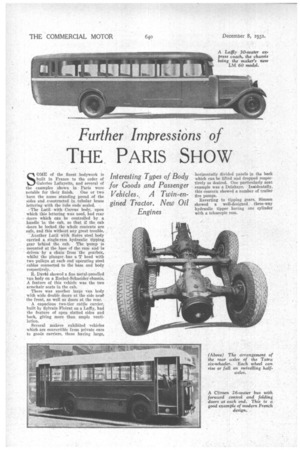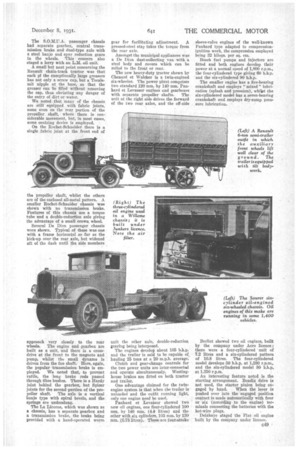• Further Impressions of
Page 70

Page 71

If you've noticed an error in this article please click here to report it so we can fix it.
THE PARIS SHOW
Interesting Types of Body for Goods and Passenger Vehicles., A Twin-engined Tractor. New Oil Engines
SOIVIE of the finest bodywork is built in France to the order of Galeries Lafayette, and several of the examples shown in Paris were
notable for their finish. One or two have the name standing proud of the sides and constructed in tubular brass lettering with the tube ends sealed.
, The Latil with Currus body, upon which this lettering was used had rear doors which can be controlled by a handle in the cab, so that if the cab doors be locked the whole contents are safe, and this without any great trouble. , Another Lath' with Suere steel body carried a single-ram hydraulic tipping gear behind the cab. The 1punap• is mounted at the base of the ram and is driven by a chain from the gearbox, whilst the plunger has a T head with two pulleys at each end operating steel cables connected to the base and body respectively.
R. David showed a fine metal-panelled van body on a Rochet-Schneider chassis. A feature of this vehicle was the two armchair seats in the cab.
There was another large van body with wide double doors at the side neat the front, as well as doors at the rear. .
A capacious two-tier cattle carrier, built by Sylvain Ploirat on a Laffly, had the feature of open slatted sides and hack, giving more than ample ventilation.
Several makers exhibited vehicles win& are convertible from private ears to goods carriers, these having large, horizontally divided panels in the back which can be lifted and dropped respectively as desired. One particularly neat example was a Delahaye. Insidentally, this concern showed a number of trailer fire pumps. Reverting to tipping gears. Simson showed a well-designed three-way hydraulic tipper having one cylinder with a telescopic ram. The S.0.11.U.A. passenger chassis had separate gearbox, central transmission brake and dual-type axle with a steel banjo and spur reduction gears in the wheels. This concern also staged a lorry with an L.M. oil unit.
A small but neat point concerning the Renault chain-track tractor was that each of the exceptionally large greasers has not only a .screw cap, but a Tecalemit nipple at the base, so that the greaser can be filled without removing the cap, thus obviating any danger of the entry of dirt or water.
We noted that many of the chassis are still equipped with fabric joints, some even on the rear portion of the propeller shaft, where there is considerable movement, but, in most cases, some centring device is employed.
On the Roehet-Schneider there is a single fabric joint at the front end of
the propeller shaft, -whilst the others are of the enclosed all-metal pattern. A smaller Rod:let-Schneider chassis was shown with no transmission brake. Features of this chassis are a torque tube and a double-reduction axle giving the advantage of a small crown wheel.
Several De Dion passenger chassis were shown. Typical of these was one with a frame horizontal so far as the kick-up over the rear axle, but widened aft of the dash until the side members approach very closely to the rear wheels. The engine and gearbox are built as a unit, and there is. a crossdrive at the front to the magneto and pump, whilst the small dynamo is driven from the fan shaft. Here, again, the popular transmission brake is employed. We noted that, to prevent rattle, the long brake rods passed through fibre bushes. There is a Hardy joint behind the gearbox, but Spicer joints for the seeond'portion of the pro peller shaft. The axle is a vertical banjo type with spiral bevels, and the springs are underslung.
The La Lieorne, which was shown as a chassis, has a separate gearbox and a transmission brake, the brake being provided with a hand-operated worm.
gear for facilitating adjustment. A pressed-steel stay takes the torque from the rear axle.
Amongst the municipal appliances was a De Dion dust-collecting van with a steel body and covers which can be rolled to the front or rear.
The new heavy-duty tractor shown by Chenard et Waleker is a twin-engined Aix-wheeler. The power plant comprises two standard 120 mm. by 140 ram. Panhard et Levassor engines and gearboxes with separate propeller shafts. The unit at the right side drives the forward of the two rear axles, and the off-side unit the other axle, double-reduction gearing being interposed. The engines develop about 105 b.h.p. and the trailer is said to be capable of hauling 25 tons at a 20 m.p.h. average. Clutch and gear-change controls, for the two power units are inter-connected and operate simultaneously. Westinghousm brakes are fitted on both tractor and trailer, One advantage claimed for the twinengine system is that when the trailer is unloaded and the outfit running light, only one engine need be used. Panhard et Levaisor showed two new oil engines, one fimr-eylindered 100 mm. by 140 mm. (4.4 litres) and the other with six cylinders, 105 mm. by 130 mm. .(6.78 litres). These-are. four-stroke sleeve-valve engines of the well-known Panhard type adapted to compressionignition work, the compression employed being 32 kilogs. per sq. em.
Bosch fuel pumps and injectors are fitted and both engines develop their power at a normal speed of 1,800 r.p.m., the four-eylindered type giving 60 b.b.p. and the six-cylindered 90 b.h.p.
The smaller engine has a five-hearing crankshaft and employs " mixed" lubrication (splash and pressure), whit the six-cylindered model has a seven-bearing crankshaft and employs dry-sump pressure lubrication.
Berliet showed two oil engines, built by the company under Acre licence ; there were a four-cylindered unit of 7.2 litres and a six-cylindered pattern of 10.8 litres. The four-cylindered model develops 50 b.h.p. at 1,380 r,p.m., and the six-cylindered model 80 h.h.p. at 1.350 r.p.m.
An interesting feature noted is the starting arrangement. Bendix drive is not used, the starter pinion being en gaged by hand. When the lever is pushed over into the engaged position contact is made automatically with four Or six (according to the engine) terminals connecting the batteries with the hot-wire plugs.
Delahaye staged the Fiat oil engine built by the corapany under licence.














































































































